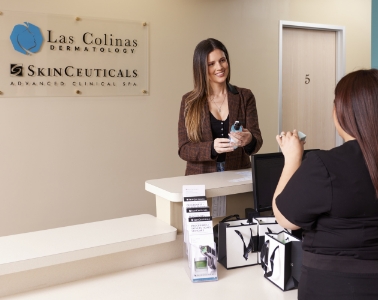Moles are growths on the skin that are typically flesh-colored, light pink or brown; they may be located anywhere on the body. A birthmark is a red or brown mark or growth that appears within a year or two after a baby’s birth.
Types Of Moles & Birthmarks
There are many types of moles and birthmarks, including the following:
- Congenital or birthmark mole (these may be larger than moles acquired later in life)
- Atypical or dysplastic mole (irregular color and/or undefined borders)
- Cafe-au-lait spot (light-brown patch)
- Small flat brown moles from sun exposure
- Hemangioma (red or purple birthmark)
- Soft raised flesh-colored or light brown moles; these occur even in non sun-exposed areas
- Port-wine stain (dark red flat birthmark)
Diagnosis Of Moles & Birthmarks
A thorough dermatologic examination of the skin is necessary to determine whether a mole or birthmark needs immediate treatment or needs to be checked on a recurring basis. Dr. Black and Cheryl Sundlov, PA-C have the training and background to identify these moles or marks and recommend appropriate monitoring and treatment.
Atypical Or Dysplastic Moles
A patient with atypical or dysplastic moles may have a higher risk of melanoma. Some atypical moles have the potential to be or become melanoma. Atypical moles may have one or more of these features:
- Asymmetry, where one side of the mole is not like the other
- Border irregularity, with scalloping or irregular borders
- Color – containing more than one color or multiple shades of brown
- Diameter larger than a pencil eraser, or 6mm
- Evolving; any changes can signal an atypical mole
- Moles should also be examined if they are in a difficult-to-monitor area like the scalp, or if they are itching or bleeding.
If a mole has one or more of these features and needs to be evaluated further, either the entire mole is removed or a small tissue sample taken, in order to biopsy it. Sometimes additional removal with a margin of normal skin is recommended, depending on the degree of abnormality of the cells.
Treatment Of Moles & Birthmarks
Although many moles and birthmarks are completely benign and pose no health risk, some people choose to remove them because they consider them unattractive, or because they rub on clothing or jewelry. Dr. Alison Black and Cheryl Sundlov, PA-C focus on achieving the best possible cosmetic result for our patients while removing even small benign growths.
Depending on its depth, location and color, as well as factors that include the patient’s skin type and age, treatment for a benign mole or birthmark includes:
- Laser or pulsed-light therapy (for red birthmarks)
- Shave biopsy, punch biopsy or surgical removal
Melanoma In Situ & Melanoma
If a mole is diagnosed as malignant, it will be called melanoma in situ, meaning the skin cancer is only on the skin’s surface, or melanoma, meaning it has invaded into the deeper skin layer or layers. In either case the entire mole will be removed, along with a margin of normal skin around it. If the malignancy is caught early enough, this may be the only treatment needed.
A melanoma that has spread beyond the skin requires more aggressive treatment, which may include:
- Surgery to remove affected lymph nodes
- Radiation therapy
- Chemotherapy
- Biological therapy to boost the immune system
- Targeted therapy (attacks vulnerabilities in cancer cells)
Risk Factors For Melanoma
Certain factors may increase the risk of melanoma, including:
- Fair skin (especially very fair skin with red hair)
- History of sunburn
- Family history of melanoma
- Excessive UV-radiation exposure from the sun or tanning beds
- Living close to the equator or at higher elevations
- Having several moles or a history of atypical moles
- Weakened immune system
Prevention Of Melanoma
While melanoma may have an inherited component and may not always be preventable, these measures may reduce your risk:
- Wear an SPF 30 or greater sunscreen on exposed skin at all times, both daily and for outdoor sports activities
- Try to avoid the sun between 10:00 and 2:00, when its rays are most intense
- Wear protective clothing such as a hat, long sleeves and pants when outdoors
- Do a monthly self-exam of your moles, looking for any changing or new ones
- Schedule a regular skin exam with Dr. Alison Black or Cheryl Sundlov, PA-C. Call us at 972.432.0300 to schedule your appointment.

